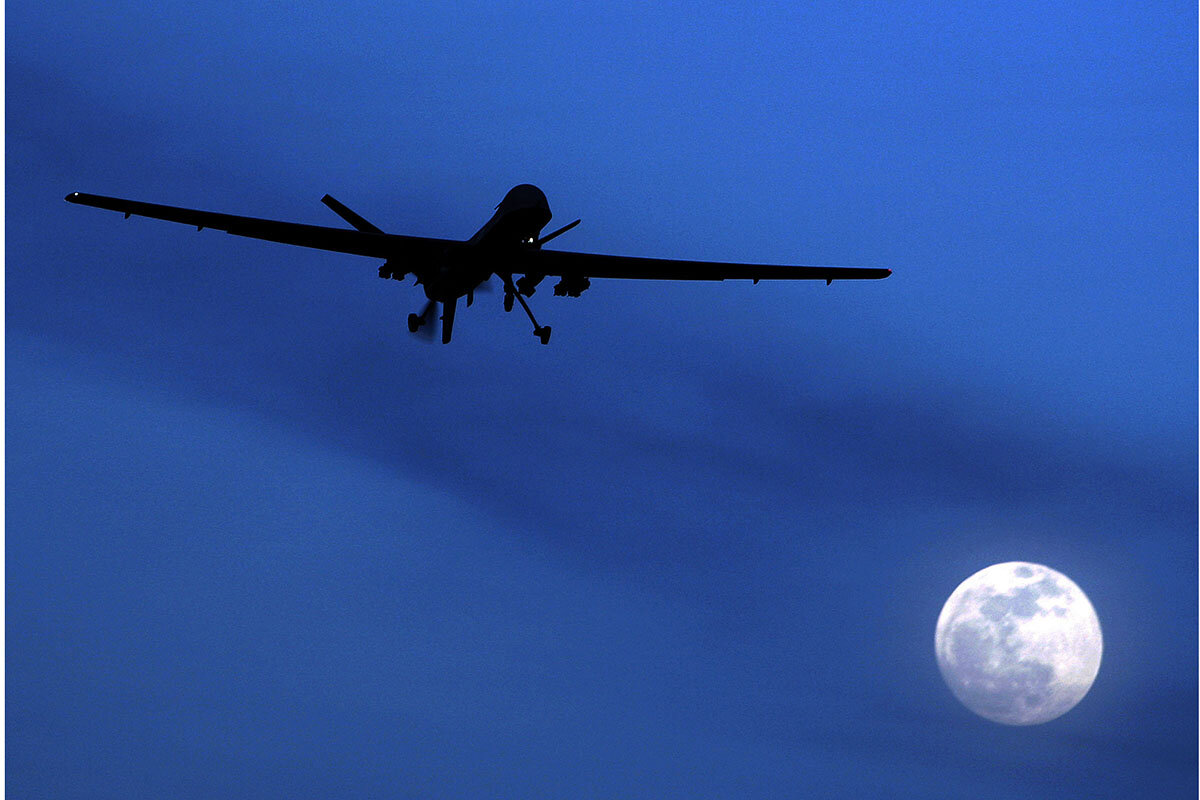State-sponsored assassination: New tools, old questions
Loading...
| London
It was over within seconds: a hail of gunfire amid the hills and orchards east of Tehran. Yet last month’s deadly strike against a key figure in Iran’s nuclear program has roots stretching back 2,500 years, to an ancient struggle for supremacy in China – and future implications going well beyond its effects on today’s Middle East.
For the attack on Mohsen Fakhrizadeh was the latest sign that assassination (“targeted killing” in modern military parlance) – a practice shunned internationally and legally proscribed for over a century – is finding official favor again and making a comeback.
And where once the assassin may have wielded simply a sharp knife, today he might use space-age technology. According to the latest Iranian account of the attack on Mr. Fakhrizadeh, almost certainly carried out by the Israelis, he was killed by a truck-mounted machine gun. But no one fired it, Iran said. It was operated by remote control via satellite, using facial recognition technology to confirm they had the right man.
Why We Wrote This
State-sanctioned assassination appears to be back in fashion. But as nonstate actors too acquire drones for “targeted killings,” will that convince the great powers to think again?
Advances in military technology, such as drones and other remote-control weaponry, have made targeted killings easier for all sorts of actors, not only sophisticated national armies.
The nature of war, too, has changed: Since the 2001 Al Qaeda attack on the twin towers in New York, conflicts between countries have given way to a more nebulous “war on terror” against nonstate groups.
Whether a new age of assassination has dawned depends on a tangle of thorny questions. Some are familiar, such as the ethical and legal issues behind past international prohibitions of such attacks: the need to avoid injuring civilians, for instance, or to demonstrate a compelling military reason for striking. There are also questions as to whether such attacks actually achieve their aim, or lead to unintended and unforeseen consequences.
Yet looking ahead, it might be an entirely different and more practical concern that prompts any international moves to put new legal guardrails in place. The technology that governments use to target individuals for assassination is increasingly easily available to those individuals for use against governments.
Still, so far there seems no sign the trend is abating.
This may have something to do with the rise of nationalism and the weakening of international alliances and institutions.
That could help explain why old-style attacks by authoritarian regimes against their own rivals or dissidents have also been getting so brazen in recent years. Russia has used the deadly chemical polonium and a military-grade nerve agent against former security-service officers living in Britain, and gunned down a former insurgent from Chechnya in a Berlin park. North Korean agents employed a nerve agent to kill a half-brother of dictator Kim Jong Un in the departure hall of Kuala Lumpur International Airport in Malaysia.
To understand the resurgent use of assassination – and the readiness of once-reticent Western powers like the United States to employ it – you need to look at how the practice got started more than 2 1/2 millennia ago, how it spread, and how it ultimately fell into international disfavor.
In ancient China, the tactic was seen not so much as a tool of all-out war, but as part of a prudent leader’s strategy to avoid a costly, protracted struggle against a powerful rival. That was the context in which the Chinese military strategist Sun Tzu – in his famous tract “The Art of War” – advocated using spies to locate and kill an enemy’s key commanders and his lieutenants.
Over the centuries, assassination attacks became a common tactic around the world, used by leaders of weaker forces – or insurgents, or disaffected individuals – in order to level the odds against more powerful rivals. Their frequency in 15th -century Italy, including the so-called Pazzi Conspiracy against the Medici family’s rule in Renaissance Florence, figured in Niccolo Machiavelli’s “The Prince.” No fewer than five of pre-Soviet Russia’s emperors were assassinated.
Little surprise, then, that it was the established powers which moved in the latter part of the 19th century, to ban assassinations. That consensus hardened after World War I, a conflict sparked by the 1914 assassination of Austrian Archduke Franz Ferdinand by a Serbian nationalist. After World War II the Geneva Conventions barred the killing of anyone not directly involved in combat.
As American academic Audrey Kurth Cronin pointed out in a fascinating article on state-sanctioned assassination early this year, in the journal Lawfare, major governments wanted to outlaw assassination not just because they believed it was “the right thing to do; it was how modern nation-states consolidated their power.”
Yet that consensus has been unravelling – and nowhere more so than in the region that the latest Tehran attack has propelled back onto the front pages: the Middle East.
The very term “assassin” originated in what is now Iran. In the 1100s, a minority sect of Islam, seeking to expand its influence, organized knife-wielding squads to kill rival leaders. These units were known as the Hashishiyyun, from their reputation for using hashish before setting off on missions.
This weak-versus-strong equation also helps explain Israel’s venture into targeted killings in the 1970s. The country was surrounded by Arab states with large, well-armed standing armies, which rejected its very existence as a state, while also facing a challenge from Palestine Liberation Organization guerrillas.
The immediate catalyst was the attack by the PLO’s “Black September” faction on Israeli athletes at the 1972 Munich Olympics. For years afterward, special Israeli units tracked down and killed dozens of Palestinians whom the Israelis held responsible for the Olympic assault and other attacks. A desire for punishment and revenge was surely a factor in the campaign. But Israelis involved in it have insisted that the main aim was more defensive and future-focused: deterrence.
Israel’s widened use of targeted killings since the early 2000s might also have made sense to Sun Tzu as a hedge against all-out war.
Wars have broken out anyway, against the Islamist Hamas government of Gaza, and Iranian-armed Hezbollah militia forces across the northern border in Lebanon. But by killing individual Palestinian military figures in Gaza, and more than a dozen people involved in the nuclear program inside Iran, Israel has sought to forestall more complicated, boots-on-the-ground conflicts.
The calculation for the Americans has been similar, especially in light of widespread reluctance among voters and politicians of both parties to send U.S. troops into major combat since the 2003 Iraq War.
Advances in military technology have encouraged Washington to rely more often on targeted killings of Al Qaeda and Islamic State leaders, and others. Some of those attacks have caught the public’s attention and stirred legal and political debate, not least because of the frequent risk of civilian casualties in such operations.
But much of the information about such attacks, especially those involving America’s Central Intelligence Agency, has been held back. Widespread attention and public scrutiny have been limited largely to the deaths of major figures such as Al Qaeda leader Osama bin Laden at the hands of special operations forces, and Qassem Soleimani, commander of Iran’s military forces in Syria, Lebanon, and elsewhere in the Middle East, killed by a drone-launched missile.
Hundreds of other drone strikes on individuals deemed dangerous by the U.S. have gone almost unnoticed. Barack Obama brought U.S. troops home during his time in office, but he sought to minimize the impact of their withdrawal by authorizing some 500 drone operations.
Speaking to The Atlantic near the end of his second term, he said he had come to realize “the dangers of a form of warfare that is so detached from what is actually happening on the ground.” He had therefore initiated moves to implement internal “checks and balances.”
Not long before leaving office, he also issued an executive order requiring the release of information on the number of civilians killed in such attacks outside combat zones. But President Donald Trump rescinded the order last year, and has overseen a fresh surge in deadly American drone attacks.
Though such operations are permitted under U.S. domestic law, even the Trump administration, despite its resistance to international oversight of American actions, still seems sensitive to long-held standards such as the Geneva Conventions and other rules of conflict. After General Soleimani’s assassination – which occurred in Iraq, a country with which the U.S. is not at war – officials argued that it was a necessary act of self-defense, given his role in an alleged imminent attack against Americans.
The United Nations’ top investigator of extrajudicial killings rejected that argument on the grounds that there was “insufficient evidence provided of an ongoing or imminent attack,” which meant that the assassination breached international law.
It seems unlikely, in the current international climate, that legal or political pressure could rein in assassination as a tactic. More persuasive, perhaps, is the fact that the U.S., its European allies, and Israel are not alone in their ability to deploy new technology. Iran can deploy armed drones too, as can its Houthi allies fighting in a civil war in Yemen. Islamic State forces appear to have formed a unit equipped with drones capable of delivering explosive charges.
In a particularly dramatic sign of how accessible such capabilities are becoming, a CNN investigation found that opponents of Venezuelan President Nicolás Maduro built the explosive drones that swooped in on him during a high-profile public address in 2018 from a kit bought from a U.S. supplier on the internet. The attempt on Mr. Maduro’s life failed, but only because the explosive charge detonated a few seconds prematurely.
In other words, the proliferation of assassination could once again enable less powerful states, and nonstate actors, to level the odds against more powerful adversaries. Not for the first time in assassination’s controversial history, the self-interest of major powers may prove to matter most in deciding its future.







